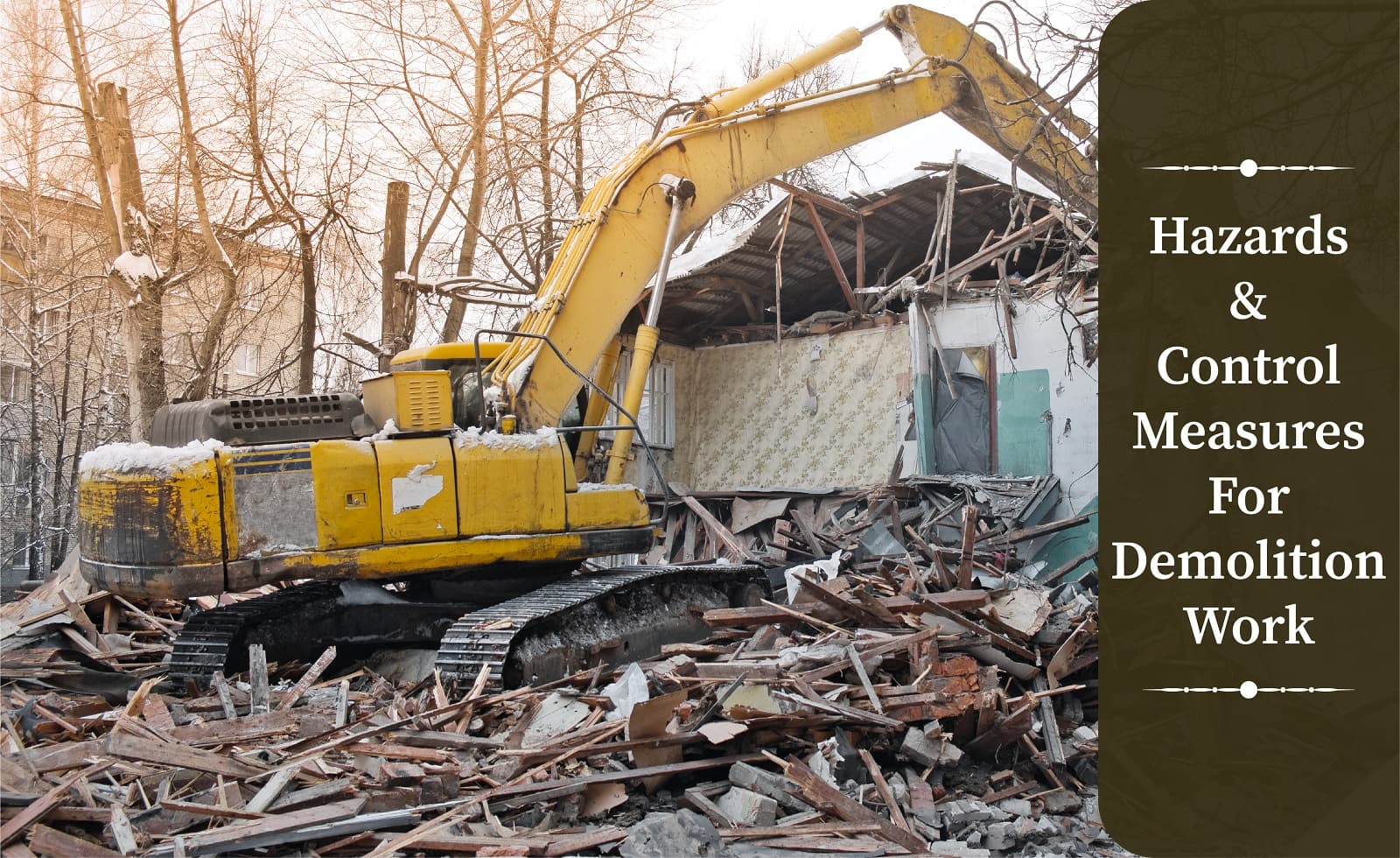
Table of Contents
Quick Summary
- Demolition work involves tearing down old buildings using heavy machinery. The process may pose high safety risks if not monitored.
- Workers may face hazards such as falling from heights, collapsing structures, sharp debris, noise, dust, vibration, and machinery accidents.
- These hazards can result into serious injuries, including fractures, burns, respiratory issues, hearing loss, and even death.
- Proper training for the workers is a sure preventive. It helps workers handle tools, follow safe procedures, and reduce human error.
- PPE such as helmets, gloves, boots, and safety glasses protects workers from immediate impact harm.
- Continuous monitoring of dust, noise, and vibration helps maintain safe conditions.
- A clean and organised site prevents slips, trips, and tool-related injuries.
- Risk assessments, method statements, and timely waste disposal further reduce site dangers.
If your construction site is carrying out demolitions, then there are potential hazards that could emerge. However, by taking careful steps to lower the risk, you can improve the working conditions for your employees. Below, we explore the main hazards and control measures for demolition work.
What is Demolition?
A demolition refers to the process of tearing down and removing old buildings and structures. Naturally, the force required to achieve this poses many dangers and risks. Workers will use powerful tools and operate heavy machinery to carry out demolitions, meaning training is crucial. Unsurprisingly, demolition jobs are the leading cause of injuries in the construction industry.
Main Demolition Hazards and Consequences
There are plenty of hazards that are associated with demolitions. Indeed, falling from a height, collapsing structures, noise, debris and mistakes with machinery all pose significant risks to workers. The injuries that can occur as a result can be incredibly serious. Death, broken bones, respiratory problems, burns and more can all happen as a result of working on demolitions.
Demolition Control Measures
01. Training for Demolition Work

Training is one of the best ways to lower risk. By empowering your employees with expert training, you can give them the tools to keep themselves safe. Reducing human error can help you avoid many accidents.
02. Wearing PPE during Demolition Work

If an accident does occur, then PPE can help limit the damage suffered. A hard hat, durable clothing, boots and work gloves are essential for protecting your employees.
03. Monitor Noise, Vibration and Dust
You should also continuously monitor your workplace to identify when safety standards are falling. By consistently measuring noise, vibration and dust levels you can step in and make changes when the workplace becomes more dangerous.
04. A Clean Site is a Safe Site
You should also ensure that your site is always clean and tidy. If tools are left lying around, your employees can easily injure themselves in an accident. What’s more, slippery or uneven flooring can lead to more accidents too.
05. Risk Assessment and Method Statements are Essential

The threat of hazards can be lowered by risk assessments and method statements. A risk assessment is where you scan your workplace to try and identify potential hazards, before acting to resolve them. Meanwhile, you should produce method statements as documents listing how to carry out individual tasks safely.
06. Manage Waste Disposal
Finally, you should ensure that you remove any waste safely from the site as soon as possible to keep the workplace neat and tidy.
In the end, demolition jobs are naturally dangerous. But by following the advice above, you should be able to limit the risk your employees are exposed to during their daily work.
Read More: Mechanical Grapples: Transforming Excavation and Demolition
FAQs on Hazards & Control Measures for Demolition
1. What are the Biggest Dangers in Demolition Work?
The biggest dangers include collapsing structures, falling materials, machinery mishandling, dust exposure, noise, and vibration. These hazards can cause severe injuries if workers are not trained, protected by PPE, or supervised through proper safety checks.
2. Why Training is Important before Starting Demolition Tasks?
Training helps workers understand demolition sequences, equipment use, emergency actions, and hazard recognition. The knowledge lowers the chances of mistakes, improves coordination, and also ensures every task is carried out with safer, more controlled methods on-site.
3. How does PPE Protect Workers during Demolition?
PPE reduces the severity of injury severity by shielding the head, eyes, hands, and feet from falling debris, sharp objects, and dust. Helmets, gloves, boots, and safety glasses offer basic yet essential protection throughout demolition activities.
4. Why must Dust, Noise, And Vibration be Monitored on Demolition Sites?
Dust affects breathing, noise harms hearing, and vibration may weakens structures around. Regular monitoring is helpful in multiple ways. It helps early identification of unsafe levels, so that supervisors can act quickly and maintain a safer environment for everyone working nearby.
5. How does Site Cleanliness Improve Demolition Safety?
A tidy site removes tripping hazards. Also, it prevents accidental tool injuries, and keeps walkways open for safe movement. Clearing debris and organising tools reduces unexpected accidents and the practice ensures higher level of control over daily demolition tasks.
6. What Role does Risk Assessments Play in Demolition Projects?
Risk assessments are effective in multiple ways. It helps in identifying possible dangers, evaluate their impact, and help mapping the safety steps needed before work starts. If paired with method statements, the risk assessment process can be used for providing clear instructions to complete each demolition task with reduced risk.






























